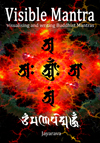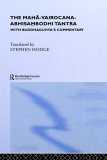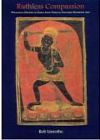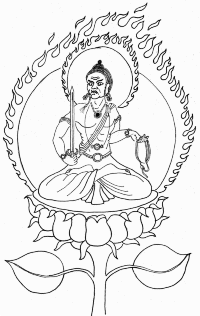

a ca la vi dyā rā ja
不 動 明 王
fu dō myō ō
Acala-vidyārāja is known in Japan as Fudō-myōō. He is a wrathful figure associated with Vairocana. He is frequently described as a messenger, but his main function in the Mahāvairocana Abhisaṃbodhi Tantra is as a destroyer of obstacles.
In the MAT he is described thus:
"He holds a sword and a noose,
his plaited hair hangs from the left of his head,
he is well adorned and one of his eyes squints.
He abides amidst his own light*,
wrathfull seated upon a rock.
His face is creased in anger,
and he has a robust youthful form."
- (MAT II.40. Hodge : 113)
Acala means "immovable". Vidya can mean knowledge, but is also a synonym for mantra and is frequently used to refer to magic. It can be taken to mean something like esoteric knowledge. Rāja means "king". He is also known simply as Acala (Fudō), or as Acalanātha, "immoveable lord". Fudō is also part of a group of Vidyārājas.
Seed Syllable.
Fudō's seed syallble is hāṃ, or sometimes hāmmāṃ, which is a combination of the two final bīja's from his mantra.
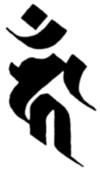 hāṃ in Siddham |
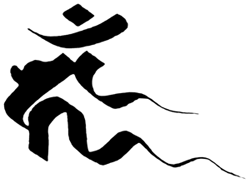 hāṃ in decorative Siddham |
 hāmmāṃ in Siddham |
Mantra
Siddhaṃ

Tibetan - Uchen

Devanāgarī
न मः स म न्त व ज्रा णां च ण्ड म हा रो ष ण स्फो ट य हूँ त्र ट् हाँ माँ
नमः समन्तवज्राणां चण्डमहारोषणस्फोटय हूँ त्रट् हाँ माँ
Transliteration
na maḥ sa maṃ ta va jrā nāṃ ca ṇḍa ma hā ro ṣa ṇa spho ṭa ya hūṃ tra ṭ hāṃ māṃ
namaḥ samantavajrānāṃ caṇḍa-mahāroṣaṇa-sphoṭaya hūṃ traṭ hāṃ māṃ
Notes
The mantra comes from the Mahāvairocana Abhisaṃbodhi Tantra. It occurs for instance in chp. 4, the General Mantra Treasury (Hodge : 161). Acala is one of only three wrathful figures in the MAT along with Trailokyavijaya and Hayagrīva.
This is a wrathful mantra which includes words which must be understood in the context of Tantric Buddhism. For instance caṇḍa means "violent", mahāroṣaṇa means "great wrath", and sphoṭaya (or sometimes sphoṭya) means "destroy". Anger is associated with, and transformed through Tantric practices into the Mirror like Wisdom of Akṣobhya that sees perfectly clearly. The energy of the anger is directed towards breaking through to Buddhahood, it breaks through spiritual ignorance. There is no sense in which this justifies expressing mundane anger towards people as the anger of the Bodhisattva arises out of Compassion for their suffering, and is rooted in Perfect Wisdom. The Mahāvairocana Abhisaṃbodhi Tantra insists that the mantra is to be recited while keeping Bodhicitta in mind:
"Recollecting bodhicitta, the matrin
Should mentally recite the Acala mantra,
And make his Mudrā,
And he will destroy all obstacles." (MAT III.4. Hodge : 154)
As well as destroying obstacles, the Acala mantra can be used for occupying the ground where a mandala is being created. Tantric texts seem to assume that creating a mandala is something that one does on an actual plot of land, although this could of course be symbollic.
In later tantric texts Chaṇḍa Mahāroṣaṇa becomes a distinct figure.
References
- Hodge, Stephen. The Mahāvairocana Abhisaṃbodhi Tantra
: with Buddhaguhya's commentary. London, Routledge Curzon : 2003.
- Linrothe, Rob. Ruthless compassion
: wrathful deities in early Indo-Tibetan esoteric Buddhist art. London, Serindia : 1999.
Note that the MAT is no longer extant in Sanskrit. Stephen Hodge's translation from the Tibetan is far superior to either Yamamoto's or Giebel's from Chinese.

